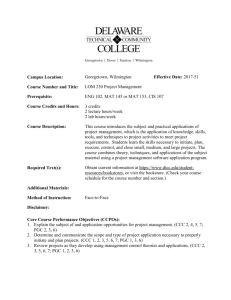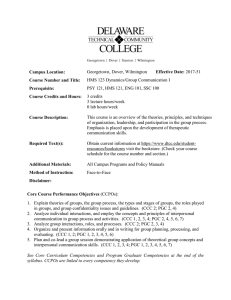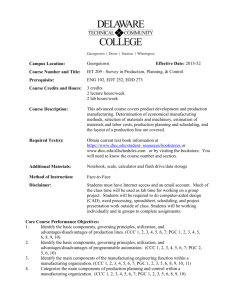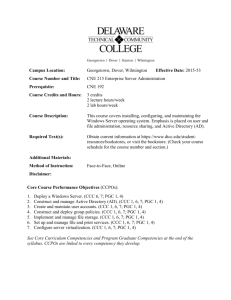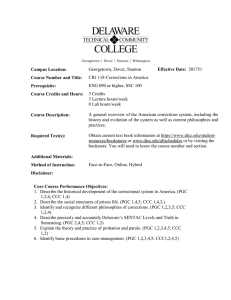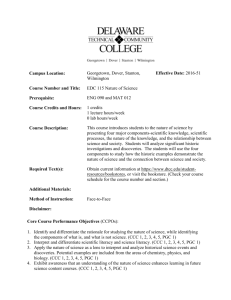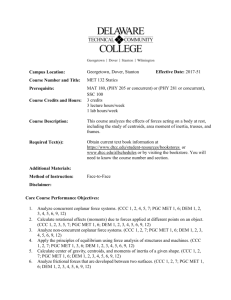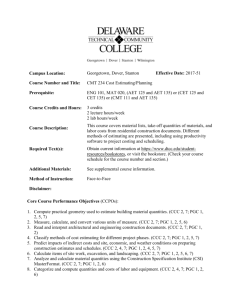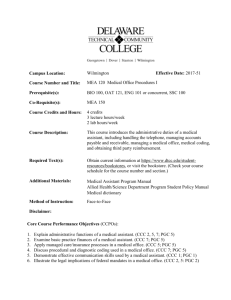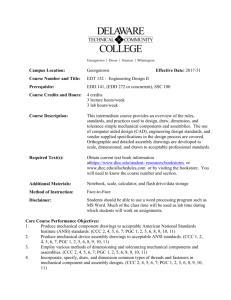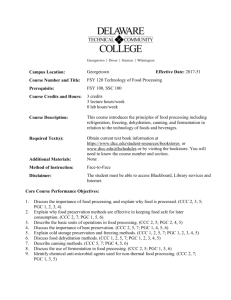Campus Location: Stanton Effective Date: 2017
advertisement
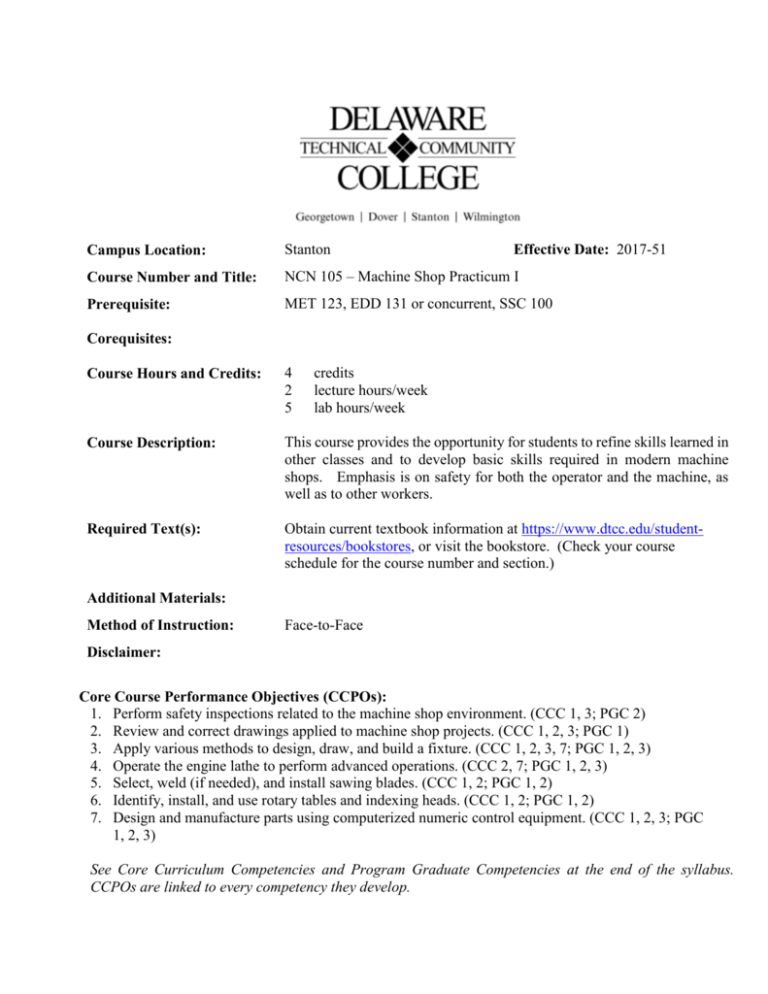
Campus Location: Stanton Effective Date: 2017-51 Course Number and Title: NCN 105 – Machine Shop Practicum I Prerequisite: MET 123, EDD 131 or concurrent, SSC 100 Corequisites: Course Hours and Credits: 4 2 5 credits lecture hours/week lab hours/week Course Description: This course provides the opportunity for students to refine skills learned in other classes and to develop basic skills required in modern machine shops. Emphasis is on safety for both the operator and the machine, as well as to other workers. Required Text(s): Obtain current textbook information at https://www.dtcc.edu/studentresources/bookstores, or visit the bookstore. (Check your course schedule for the course number and section.) Additional Materials: Method of Instruction: Face-to-Face Disclaimer: Core Course Performance Objectives (CCPOs): 1. Perform safety inspections related to the machine shop environment. (CCC 1, 3; PGC 2) 2. Review and correct drawings applied to machine shop projects. (CCC 1, 2, 3; PGC 1) 3. Apply various methods to design, draw, and build a fixture. (CCC 1, 2, 3, 7; PGC 1, 2, 3) 4. Operate the engine lathe to perform advanced operations. (CCC 2, 7; PGC 1, 2, 3) 5. Select, weld (if needed), and install sawing blades. (CCC 1, 2; PGC 1, 2) 6. Identify, install, and use rotary tables and indexing heads. (CCC 1, 2; PGC 1, 2) 7. Design and manufacture parts using computerized numeric control equipment. (CCC 1, 2, 3; PGC 1, 2, 3) See Core Curriculum Competencies and Program Graduate Competencies at the end of the syllabus. CCPOs are linked to every competency they develop. Measurable Performance Objectives (MPOs): Upon completion of this course, the student will: 1. Perform safety inspections related to the machine shop environment. 1.1 1.2 1.3 Inspect the work area for unsafe conditions, including chemical and material storage and machine safeguarding. Complete a finding report based on an inspection. Research and produce recommendations using Occupational Safety and Health Administration (OSHA) standards. 2. Review and correct drawings applied to machine shop projects. 2.1 2.2 2.3 Evaluate current shop project drawings for accuracy and completeness. Make written recommendations for changes to current drawings. Create new computer aided design (CAD) drawings incorporating all necessary changes. 3. Apply various methods to design, draw, and build a fixture. 3.1 3.2 3.3 3.4 Design fixtures to be used for machining and inspection of shop projects. Using a CAD system, appropriately create necessary drawings for the new project. Using the shop equipment, manufacture the newly designed fixture. Re-evaluate the manufacturing project, and make recommendations for drawing/process changes. 4. Operate the engine lathe to perform advanced operations. 4.1 4.2 4.3 4.4 4.5 4.6 4.7 Perform taper turning by using the following methods: offsetting the tail stock, using the taper attachment, and setting the compound rest. Identify and set up a chucker lathe to produce a sample project. Use a tracer attachment on a lathe. Machine 60-degree and acme threads on a lathe. Satisfactorily knurl selected materials using several knurling tools. Machine with a lathe using a mandrel. Adjust and perform normal maintenance on lathes. 5. Select, weld (if needed), and install sawing blades. 5.1 5.2 5.3 5.4 Select appropriate material used for saw blades. Perform welding operations on several types of bandsaw materials. Safely use the bandsaw and cut off saws to cut selected materials. Demonstrate maintenance and normal upkeep of common sawing machines. 6. Identify, install, and use rotary tables and indexing heads. 6.1 6.2 6.3 Explain the differences between a rotary table and an indexing head. Set up and use a rotary table to machine a sample part. Install and align an indexing head for vertical and horizontal usage. 7. Design and manufacture parts using computerized numeric control equipment. 7.1 7.2 7.3 Write a computer numerical control (CNC) program for sample projects on the Haas vertical machining center that includes tool selection and installation, drilling, tool offsets, multiple parts, speeds and feeds, reaming, and contouring. Produce a program using the CNC lathe. Save programs to disk and on individual CNC machines. Evaluation Criteria/Policies: Students will demonstrate proficiency on all CCPOs at a minimal 75 percent level to successfully complete the course. The grade will be determined using the DTCC grading system: 92 – 100 83 – 91 75 – 82 0 – 74 = = = = A B C F Students should refer to the Student Handbook (https://www.dtcc.edu/academics/studenthandbook) for information on the Academic Standing Policy, the Academic Honesty Policy, Student Rights and Responsibilities, and other policies relevant to their academic progress. Core Curriculum Competencies: (CCCs are the competencies every graduate will develop): 1. Communicate clearly and effectively both orally and in writing. 2. Demonstrate effective problem solving and reasoning skills. 3. Work effectively in groups of people from diverse backgrounds. 4. Demonstrate ethical and professional understanding and conduct. 5. Apply appropriate information literacy skills to locate, evaluate and use information effectively. 6. Use computer technology appropriate to the field. 7. Use scientific and mathematical reasoning appropriate to the technology. Program Graduate Competencies: (PGCs are the competencies every graduate will develop specific to his/her major.) 1. Identify effective problem-solving skills for making appropriate decisions relative to the machinist profession. 2. Demonstrate basic computer applications knowledge and 3D parametric modeling software skill. 3. Use basic machining, welding operations and perform basic programming of computer numerically controlled machines.
